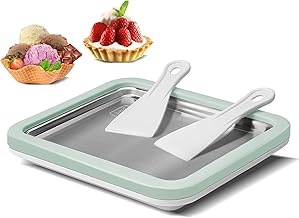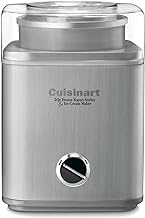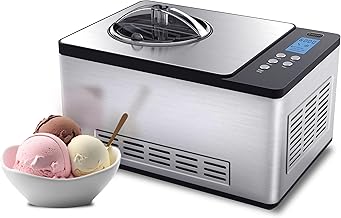How to Choose and Use the Right Ice Cream Maker at Home
- March 13, 2025
- 0
Your Guide to Choosing the Right Ice Cream Maker Making ice cream at home is a rewarding experience—whether you’re sticking with classic vanilla or experimenting with bold new
Your Guide to Choosing the Right Ice Cream Maker Making ice cream at home is a rewarding experience—whether you’re sticking with classic vanilla or experimenting with bold new
Making ice cream at home is a rewarding experience—whether you’re sticking with classic vanilla or experimenting with bold new flavors. With the right ice cream maker, the possibilities are virtually endless, giving you the freedom to craft frozen treats exactly how you like them.
However, with the wide variety of models on the market, choosing the right one can be overwhelming. This guide breaks down the key types of ice cream makers, helping you find the machine that fits your lifestyle, kitchen space, and creativity.
Before diving into brands or features, consider how you plan to use your ice cream maker. Ask yourself:
How often will you make ice cream?
Is this for weekly treats or special occasions?
How much space do you have?
Some machines are compact, while others need more counter or storage space.
How hands-on do you want the process to be?
Some machines do everything automatically, while others require more effort.
These traditional machines are perfect for those who enjoy a bit of nostalgia or hands-on involvement. They’re also great for family fun and outdoor events.
How it works:
Fill the outer bucket with ice and salt.
Pour your ice cream mixture into the canister inside.
Seal it, and turn the crank manually until the mixture freezes.
Best for:
Occasional use
Small batches
Those who want a rustic, hands-on experience

Due to their convenience, electric models are widely used. These machines have an automatic motor that churns the mixture, allowing you to focus on other things while your ice cream is being made.
Add your ice cream mixture to a bowl that has already been frozen (most models require the bowl to be frozen beforehand).
Start the machine — the motor automatically stirs the mixture, which eventually freezes.
Convenience: Simply pour in the mixture, turn on the machine, and wait for the process to be completed.
Quick: Making a batch of ice cream usually takes 20 to 40 minutes.
Reasonably priced: Electric ice cream makers are typically less costly compared to compressor-based models.
Pre-freezing is necessary for the majority of models.

Compressor-based ice cream makers are the best option if you want high performance and efficiency. These devices do not require a pre-frozen bowl because they have an integrated compressor that instantly chills the ice cream mixture.
In contrast to other varieties, compressor machines cool the mixture during churning thanks to an internal refrigeration system.
You can begin making ice cream right away and even make several batches at once.
No Pre-Freezing: You don’t have to wait for the bowl to freeze before making ice cream.
Greater Capacity: These devices can produce larger quantities, often up to two or three quarts.
Continuous Operation: Ideal for gatherings or large families where multiple batches are required.
Superior Quality: Compressor units offer better consistency and texture in the final product.
Costlier: Because of their sophisticated features, these models are more expensive.
Bulky Size: Typically heavier and larger, they might not fit well in small kitchens.
Noisier Operation: Compared to electric or manual models, the built-in compressor may produce more noise during operation.

When purchasing an ice cream maker, there are a few features that can significantly impact your experience:
Batch Size:
Ice cream makers typically make one to two quarts in a batch. Look for models that can handle higher quantities if you need to make more.
Cleaning Ease:
To simplify cleaning, pick a model with detachable parts. This will save you time and effort after every use.
Churning Speed:
The quicker the churning, the faster your ice cream is ready. Generally, electric and compressor models churn faster than manual ones.
Noise Level:
Some machines, especially compressor models, can be noisy. If this is a concern, check noise levels in the product specifications or customer reviews.
There are several advantages to making ice cream at home instead of buying store-bought options:
Customization:
You have complete control over the ingredients. Add your favorite mix-ins like chocolate chips, fruit, or spices for a personalized touch.
Healthier Options:
You can use natural ingredients, low-sugar substitutes, or non-dairy alternatives to make ice cream tailored to your dietary needs.
No Additives:
Homemade ice cream contains no preservatives or artificial flavors. What you see is what you get.
To ensure your homemade ice cream turns out smooth and creamy, consider these expert tips:
Use Chilled Ingredients:
Cold ingredients freeze faster, helping improve the texture of your ice cream.
Chill Your Mixture:
Refrigerate your ice cream mixture before churning to ensure it freezes more evenly and quickly.
Avoid Over-Churning:
Stop the machine when the ice cream reaches a soft-serve consistency. Over-churning can result in a less desirable texture.
Proper Storage:
After churning, transfer your ice cream into an airtight container and let it firm up in the freezer. Allow it to soften slightly before scooping for a smoother texture.
At Testergate, we take pride in offering thorough, frank reviews and purchasing guides to assist you in making wise choices. Here’s why Testergate should be your go-to source when looking for an ice cream maker:
Expert Reviews
After conducting extensive testing on every product, our staff offers objective assessments of its functionality, usability, and affordability.
Comprehensive Buying Guides
We provide in-depth guides that dissect the salient characteristics, advantages, and disadvantages of each model to help you choose the one that best suits your needs.
Don't overfill the machine and use ingredients that are well chilled. For a firmer texture, freeze after churning until soft-serve thick.
No. Although entry-level models do, pre-freezing is not necessary for self-cooling compressor machines.
The majority of machines produce 1–2 quarts, which is sufficient for a small family or party.
Typically, 20 to 40 minutes, depending on the recipe and machine.
Indeed. The majority of models are suitable for frozen yogurt, sorbet, and even desserts without dairy.
To enjoy homemade frozen treats, selecting the appropriate ice cream maker is essential. Knowing your requirements and preferences will help you choose the ideal machine, whether you go with an electric, manual, or compressor-based model.
At Testergate, we give you all the information you require to make an informed choice and begin making delectable, personalized ice cream at home.

